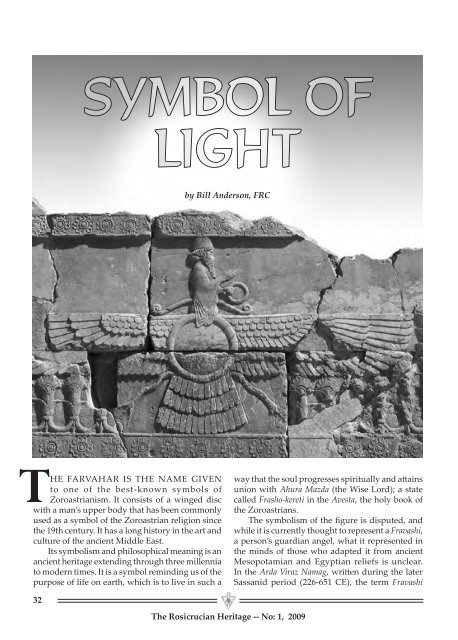Rosicrucian Heritage Magazine - 2009-03 - AMORC
Rosicrucian Heritage Magazine - 2009-03 - AMORC
Rosicrucian Heritage Magazine - 2009-03 - AMORC
Create successful ePaper yourself
Turn your PDF publications into a flip-book with our unique Google optimized e-Paper software.
SYMBOL OF<br />
LIGHT<br />
by Bill Anderson, FRC<br />
The Farvahar is the NAMe GIVen<br />
to one of the best-known symbols of<br />
Zoroastrianism. It consists of a winged disc<br />
with a man’s upper body that has been commonly<br />
used as a symbol of the Zoroastrian religion since<br />
the 19th century. It has a long history in the art and<br />
culture of the ancient Middle East.<br />
Its symbolism and philosophical meaning is an<br />
ancient heritage extending through three millennia<br />
to modern times. It is a symbol reminding us of the<br />
purpose of life on earth, which is to live in such a<br />
way that the soul progresses spiritually and attains<br />
union with Ahura Mazda (the Wise Lord); a state<br />
called Frasho-kereti in the Avesta, the holy book of<br />
the Zoroastrians.<br />
The symbolism of the figure is disputed, and<br />
while it is currently thought to represent a Fravashi,<br />
a person’s guardian angel, what it represented in<br />
the minds of those who adapted it from ancient<br />
Mesopotamian and Egyptian reliefs is unclear.<br />
In the Arda Viraz Namag, written during the later<br />
Sassanid period (226-651 CE), the term Fravashi<br />
32<br />
The <strong>Rosicrucian</strong> <strong>Heritage</strong> -- No: 1, <strong>2009</strong>












